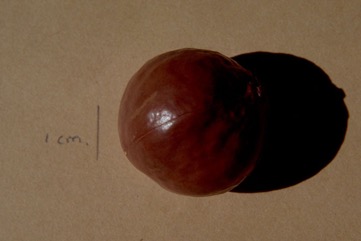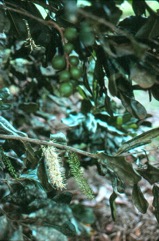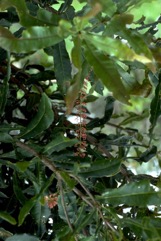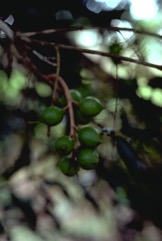Macadamia nut, Queensland nut

It is a tropical and subtropical plant. It does well with temperatures about 22-26°C. It suits a light sandy loam with pH 5.5-7.5. In Papua New Guinea it does well at 1000 to 1200 m altitude and will grow up to 1700 m.
Also known as:
Ao zhou jian guo, Gympie nut, Pohon makadam gimpi, Small-fruited Bush Nut
Synonyms
- Macadamia minor F.M. Bailey
- Macadamia lowii F.M. Bailey
- Helicia ternifolia (F. Muell.)F. Muell.
Edible Portion
- Seeds kernel, Nuts
Where does Macadamia nut grow?
Found in: Africa, Asia, Australia, Cameroon, Central Africa, China, Cuba, East Africa, Eswatini, Hawaii, India, Indonesia, Mexico, Mozambique, North Africa, Pacific, Papua New Guinea, PNG, Philippines, Puerto Rico, SE Asia, South Africa, Southern Africa, Swaziland, Taiwan, United States, Vanuatu
Notes: There are about 14 Macadamia species. They are mainly in Australia. Nuts are about 76% oil.
Growing Macadamia nut, Queensland nut
Cultivation: Trees are mostly grown from seed. They can be grown from cuttings. Pruning increases branching. A spacing of 5 to 10 m is suitable.
Edible Uses: The nuts are edible. The nuts yield an oil used with salads.
Production: Trees produce in 7 years from seed and 3-4 years from grafted trees. Nuts on some types are produced seasonally about Dec to April. Nuts are harvested after they fall. The outside husk needs to be rubbed off then the nuts dried in the sun. A kernal weighs about 3 g. A well established tree can produce 80 kg of nuts.
Nutrition Info
per 100g edible portion| Edible Part | Energy (kcal) | Protein (g) | Iron (mg) | Vitamin A (ug) | Vitamin c (mg) | Zinc (mg) | % Water |
|---|---|---|---|---|---|---|---|
| Seed | 775 | 7.46 | 0.2 | - | Tr | - | 2.5 |
Macadamia nut, Queensland nut Photos




References
Ambasta, S.P. (Ed.), 2000, The Useful Plants of India. CSIR India. p 345
Bailey, F. M., 1913, Comprehensive Catalogue of Queensland Plants. Queensland Government.
Bodkin, F., 1991, Encyclopedia Botanica. Cornstalk publishing, p 663
Bourke, R. M., Altitudinal limits of 230 economic crop species in Papua New Guinea. Terra australis 32.
Brouk, B., 1975, Plants Consumed by Man. Academic Press, London. p 218
Burkill, I.H., 1966, A Dictionary of the Economic Products of the Malay Peninsula. Ministry of Agriculture and Cooperatives, Kuala Lumpur, Malaysia. Vol 2 (I-Z) p 1403
Elliot, W.R., & Jones, D.L., 1993, Encyclopedia of Australian Plants suitable for cultivation. Vol 6. Lothian. p 264
Flora of Australia Volume 16, Elaeagnaceae, Proteaceae 1. Melbourne: CSIRO Australia (1995) p 422, 421
French, B.R., 1986, Food Plants of Papua New Guinea, A Compendium. Asia Pacific Science Foundation p 190
Gouldstone, S., 1983, Growing your own Food-bearing Plants in Australia. Macmillan p 144
Hedrick, U.P., 1919, (Ed.), Sturtevant's edible plants of the world. p 396
Hu, Shiu-ying, 2005, Food Plants of China. The Chinese University Press. p 366
Jardin, C., 1970, List of Foods Used In Africa, FAO Nutrition Information Document Series No 2.p 34
Jones D, L, 1986, Ornamental Rainforest Plants in Australia, Reed Books, p 49, 340
Kiple, K.F. & Ornelas, K.C., (eds), 2000, The Cambridge World History of Food. CUP p 1805
Lazarides, M. & Hince, B., 1993, Handbook of Economic Plants of Australia, CSIRO. p 154
Long, C., 2005, Swaziland's Flora - siSwati names and Uses http://www.sntc.org.sz/flora/
Low, T., 1991, Wild Food Plants of Australia. Australian Nature FieldGuide, Angus & Robertson. p 92
Miguel, E., et al, 1989, A checklist of the cultivated plants of Cuba. Kulturpflanze 37. 1989, 211-357
Owen, S., 1993, Indonesian Food and Cookery, INDIRA reprints. p 68
Purseglove, J.W., 1968, Tropical Crops Dicotyledons, Longmans. p 641
Ruiters-Welcome, A. K., 2019, Food plants of southern Africa. Ph.D. thesis. Univ. of Johannesburg p 93
Segura, S., et al, 2018, The edible fruit species in Mexico. Genet Resour Crop Evol (2018) 65:1767–1793
Sharma, B.B., 2005, Growing fruits and vegetables. Publications Division. Ministry of Information and broadcasting. India. p 86
Sleumer, H., 1955, Proteaceae in Flora Malesiana, Ser 1 Vol 5(2) p 196
Solomon, C., 2001, Encyclopedia of Asian Food. New Holland. p 226
Sukarya, D. G., (Ed.) 2013, 3,500 Plant Species of the Botanic Gardens of Indonesia. LIPI p 369
Trans. & Proc. Philos. Inst. Victoria 2:72. 1858
van Wyk, Be, & Gericke, N., 2007, People's plants. A Guide to Useful Plants of Southern Africa. Briza. p 22
Vivien, J., & Faure, J.J., 1996, Fruitiers Sauvages d'Afrique. Especes du Cameroun. CTA p 265
Walter, A. & Lebot, V., 2007, Gardens of Oceania. ACIAR Monograph No. 122. CD-ROM minor species p 14
Wickens, G.E., 1995, Edible Nuts. FAO Non-wood forest products. FAO, Rome. p147
Williams, C.N., Chew, W.Y., and Rajaratnam, J.A., 1989, Tree and Field Crops of the Wetter Regions of the Tropics. Longman, p 130
Williams, J.B., Harden, G.J., and McDonald, W.J.F., 1984, Trees and shrubs in rainforests of New South Wales and Southern Queensland. Univ. of New England, Armidale. p 56
World Checklist of Useful Plant Species 2020. Royal Botanic Gardens, Kew